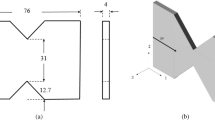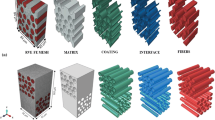Abstract
Unidirectional carbon fiber reinforced polymers (CFRP) laminates are widely employed in different fields due to their low density combined with high stiffness and strength. However, unlike usual materials, composite laminates may present many different failure mechanisms. Additionally, the stress distribution depends on the material properties due to its anisotropy, making the composite design a hard task. This study deals with a large plate made of CFRP with a central crack subject to uniaxial loading. The main goal of this investigation is to carry out an analysis of the stress distribution and the damaged area around a crack tip. The damaged area, or processed zone, is an important way to evaluate the applicability and limitations of linear elastic fracture mechanics. An analytical closed-form equation is derived using Tsai’s modulus combined with Tsai–Wu failure criterion and compared with finite element simulations. The results show the accuracy of the proposed equation and the influence of the fibers’ orientation on the processed zone shape. Due to Tsai’s modulus application, the stress distribution can be obtained for any single-layered CFRP.










Similar content being viewed by others
References
Agarwal BD, Broutman LJ, Chandrashekhara K (2006) Analysis and performance of fiber composites. Wiley, USA
Arteiro A, Sharma N, Melo JDD, Ha SK, Miravete A, Miyano Y, Massard T, Shah PD, Roy S, Rainsberger R, Rother K, Cimini C, Seng JM, Arakaki FK, Tay TE, Lee WI, Sihn S, Springer GS, Roy A, Riccio A, Francesco Di Caprio F, Shrivastava S, Nettles AT, Catalanotti G, Camanho PP, Seneviratne W, Marques AT, Yang HT, Hahn HT (2020) A case for Tsai’s modulus, an invariant-based approach to stiffness. Compos Struct 252:112683
Azzi VD, Tsai SW (1965) Anisotropic strength of composites. Exp Mech 5:283–288
Barbero EJ (2018) Introduction to composite materials design, 3rd edn. CRC Press, USA
Castro JTP, Meggiolaro MA (2016) Fatigue design techniques, crack propagation, temperature and statistical effects, 1st edn. CreateSpace, Scotts Valley
Catalanotti G, Arteiro A, Hayati M, Camanho PP (2014) Determination of the mode I crack resistance curve of polymer composites using the size-effect law. Eng Fract Mech 118:49–65
Erkan O, Sur G, Nas E (2020) Insvestigation of Surface Morphology of Drilled CFRP Plates and Optimization of Cutting Parameters. Surf Rev Lett 27:1950209
Furtado C, Arteiro A, Bessa MA, Wardle BL, Camanho PP (2017) Prediction of size effects in open-hole laminates using only the Young’s modulus, the strength, and the R-curve of the 0° ply. Compos A Appl Sci Manuf 101:306–317
Furtado C, Pereira LF, Tavares RP, Salgado M, Otero F, Catalanotti G, Arteiro A, Bessa MA, Camanho PP (2021) A methodology to generate design allowables of composite laminates using machine learning. Int J Solids Struct 233:111095
Góes RCO, Castro JTP, Martha LF (2014) 3D effects around notch and crack tips. Int J Fatigue 62:159–170
Kenedi PP, Vignoli LL, Duarte BT, Silva Neto JSE, Bandeira CFC (2022) Damage tracking of notched composite plates by thermography—Experimental observations and analytical model for damage onset. J Compos Mater 56:1211–1220
Kuraishi A, Tsai SW, Liu KKS (2002) A progressive quadratic failure criterion, part B. Compos Sci Technol 62:1683–1695
Ha SK, Cimini CA (2018) Theory and validation of the master ply concept for invariant-based stiffness of composites. J Compos Mater 52:1699–1708
Hashin Z (1980) Failure Criteria for Unidirectional Fiber Composites. J Appl Mech 47:329–334
Hill R (1948) A theory of the yielding and plastic flow of anisotropic metals. Proc R Soc Lond A 193:281–297
Hinton MJ, Kaddour AS, Soden PD (2004) Failure criteria in fibre-reinforced-polymer composites—The World-Wide Failure Exercise. Elsevier
Hinton MJ, Soden PD (1998) Predicting failure in composite laminates: the background to the exercise. Compos Sci Technol 58:1001–1010
Li S, Sitnikova E (2018) A critical review on the rationality of popular failure criteria for composites. Compos Commun 8:7–13
Li S, Sitnikova S, Liang Y, Kaddour AS (2017) The Tsai-Wu failure criterion rationalized in the context of UD composites. Compos A Appl Sci Manuf 102:207–217
Li S, Xu M, Sitnikova E (2022) The formulation of the quadratic failure criterion for transversely isotropic materials: mathematical and logical considerations. J Compos Sci 6:82
Liu KS, Tsai SW (1998) A progressive quadratic failure criterion for a laminate. Compos Sci Technol 58(7):1023–1032
Puck A, Schurmann H (1998) Failure analysis of FRP laminates by means of physically based phenomenological models. Compos Sci Technol 58:1045–1067
Reddy JN (2003) Mechanics of laminated composite plates and shells: theory and analysis, 2nd edn. CRC Press
Sih GC, Paris PC, Irwin GR (1965) On cracks in rectilinearly anisotropic bodies. Int J FractMech 1:189–203
Sokolnikoff IS (1956) Mathematical theory of elasticity, 2nd edn. McGraw-Hill Book Company, New York
Sousa RA, Castro JTP, Lopes AAO, Martha LF (2013) On improved crack tip plastic zone estimates based on T-stress and on complete stress fields. Fatigue Fract Eng Mater Struct (Print) 36:25–38
Tsai SW, Kappel E, Miravete A, Riccio A, Di Caprio F, Roy S, Yeoh KM, Liu J, Tay TE, Tan V, Wang D, Li S, Xu M, Sitnikova E, Zheng C, Jin B, Arteiro A, Sharma N, Massard T (2022) Double–double a new perspective in the manufacture and design of composites. Composite Design Group, Stanford
Tsai SW, Melo JDD (2014) An invariant-based theory of composites. Compos Sci Technol 100:237–243
Tsai ST, Melo JDD (2017) A unit circle failure criterion for carbon fiber reinforced polymer composites. Compos Sci Technol 123:71–78
Tsai SW, Sharma N, Arteiro A, Roy S, Rainsberger B (2019) Composite double-double and grid/skin structures–low weight/low cost design and manufacturing. Composites Design Group, Stanford
Tsai SW, Wu EM (1971) A general theory of strength for anisotropic materials. J Compos Mater 5:58–80
Vignoli LL, Carneiro Neto RRM, Savi MA, Pacheco PMCL, Kalamkarov AL (2021) Trace theory applied to composite analysis: a comparison with micromechanical models. Compos Commun 25:100715
Vignoli LL, Castro JTP (2021) A parametric study of stress concentration issues in unidirectional laminates. Mech Adv Mater Struct 28:1554–1569
Vignoli LL, Castro JTP, Meggiolaro MA (2019) Stress concentration issues in unidirectional laminates. J Braz Soc Mech Sci Eng 41:1–27
Vignoli LL, Kenedi PP (2022) Hybrid multiscale procedure for damage in notched unidirectional composite monitored by thermography. Polym Compos 43:4288–4296
Vignoli LL, Kenedi PP, Mariano MJB (2022) Exploring thermography technique to validate multiscale procedure for notched CFRP plates. Compos Part C Open Access 7:100241
Vignoli LL, Savi MA (2018) Multiscale failure analysis of cylindrical composite pressure vessel: a parametric study. Latin Am J Solids Struct 15:63
Vignoli LL, Savi MA, Pacheco PMCL, Kalamkarov AL (2019) Comparative analysis of micromechanical models for the elastic composite laminae. Compos Part B-Eng 174:106961
Vignoli LL, Savi MA, Pacheco PMCL, Kalamkaroov AL (2020) Multiscale approach to predict strength of notched composite plates. Compos Struct 253:112827
Vignoli LL, Savi MA, Pacheco PMCL, Kalamkaroov AL (2020) Micromechanical analysis of longitudinal and shear strength of composite laminae. J Compos Mater 54:4853–4873
Vignoli LL, Savi MA, Pacheco PMCL, Kalamkaroov AL (2020) Micromechanical analysis of transversal strength of composite laminae. Compos Struct 250:112546
Wang Y, Tayyebi M, Assari A (2022) Fracture toughness, wear, and microstructure properties of aluminum/titanium/steel multi-laminated composites produced by cross-accumulative roll-bonding process. Arch Civil Mech Eng 22:49
Xin G, Hangong W, Xingwu K, Liangzhou J (2010) Analytic solutions to crack tip plastic zone under various loading conditions. Eur J Mech A/Solids 29:738–745
Zavvar E, Hosseini AS, Lotfollahi-Yaghin MA (2021) Stress concentration factors in steel tubular KT-connections with FRP-Wrapping under bending moments. Structures 33:4743–4765
Acknowledgements
L.L. Vignoli would like to acknowledge the support of the FAPERJ and UFRJ.
Author information
Authors and Affiliations
Corresponding author
Ethics declarations
Conflict of interest
The authors declare that there is no conflict of interest in this work.
Additional information
Technical Editor: Sandro Amico.
Publisher's Note
Springer Nature remains neutral with regard to jurisdictional claims in published maps and institutional affiliations.
Rights and permissions
Springer Nature or its licensor (e.g. a society or other partner) holds exclusive rights to this article under a publishing agreement with the author(s) or other rightsholder(s); author self-archiving of the accepted manuscript version of this article is solely governed by the terms of such publishing agreement and applicable law.
About this article
Cite this article
Vignoli, L.L., Adeodato, A., de Macedo Barreto Netto, D. et al. An investigation about stresses and processed zone around crack tip in CFRP plates. J Braz. Soc. Mech. Sci. Eng. 45, 255 (2023). https://doi.org/10.1007/s40430-023-04144-7
Received:
Accepted:
Published:
DOI: https://doi.org/10.1007/s40430-023-04144-7




